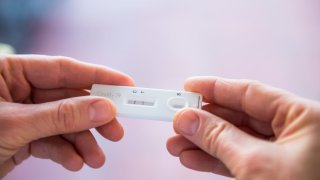
With flu and RSV seasons set to soon heighten, when should you test for COVID if you are sick and how often?
The federal government recently resumed its program of shipping out free COVID tests to households, which means many now have at-home tests available.
But when should you use them?
Here's what to know:
Feeling out of the loop? We'll catch you up on the Chicago news you need to know. Sign up for the weekly Chicago Catch-Up newsletter here.
When should you test?
Those who have symptoms are urged to take a COVID test as soon as possible, though officials continue to caution that a negative at-home test may not be as reliable as a positive one.
"If your antigen test is negative, take another antigen test after 48 hours or take a PCR test as soon as you can," the CDC states.
Those who don't have symptoms but may have been exposed should wait five days after exposure to take a test, according to the CDC guidance.
Some experts say you could test even earlier, but most recommend to continue testing through day five if those tests are negative.
“I would say the best rule of thumb is to start testing three days after exposure, and if you’re negative, test again on day four or five,” Dr. Michael Mina, a COVID testing expert and former professor of epidemiology and of immunology and infectious diseases at the Harvard T.H. Chan School of Public Health, told NBC News.
If I test negative does that mean I'm in the clear?
Those who were exposed and have symptoms are urged to continue testing for several days.
PCR tests can also pick up lower levels of the virus and would offer a more accurate determination for those looking for one.
The steps for what to do if you test negative can depend on symptoms, however.
If you have symptoms:
The FDA recommends "people who get an initial negative result on an antigen test, take at least one more test 48 hours later."
"Take a third test, 48 hours after the second, if the second test was negative and you don’t have symptoms. Self-tests are more likely to detect the virus if you have symptoms," the guidance states.
You may also want to consider contacting a healthcare provider to check for additional tests for other illnesses.
If you were exposed to someone with COVID-19, but don't have symptoms:
The CDC recommends if you test negative at least five days from your exposure that you repeat the test again 48 hours after your first test.
"If both tests are negative, then repeat testing after another 48 hours for a total of three tests," the guidance states.
What if you test positive? Does that mean you're contagious?
The answer is, "likely," especially with at-home tests,
According to the CDC, "self-tests detect current infection" and a positive result means "the virus was detected and you have an infection."
Do at-home tests work with the latest variants?
It is believe the at-home tests are still effective against the newer COVID variants.
“We’ve actually never seen a deterioration in accuracy of the tests, given any new variants,” Mina told NBC News. That’s because the mutations are happening in a different part of the virus than the portion detected by rapid tests. Almost every rapid test that’s authorized in the U.S. and globally detects a protein called the nucleocapsid, which is stable and just doesn’t, hasn’t seen a lot of mutations."
Most mutations so far have instead occurred in what is known as the spike protein.
Check the expiration dates
While many Americans may have unused tests in their homes, it's important to check the expiration dates, experts say.
The Food and Drug Administration has extended the expiration dates of many popular at-home test products, which means some such kits may still be safe to use, CNBC reports. You can check expiration dates for each brand using a page on the FDA's website.
Are COVID tests free?
Beginning on June 1, the government halted its free at-home test deliveries, but that program resumed once again at the end of September.
It is unclear how many tests currently remain in stock, though government officials say that 200 million additional tests could be manufactured using funds dispersed to test-makers in coming months.
According to officials, individuals simply need to visit COVIDtests.gov to order your free supply. The shipments each include four individual rapid antigen COVID-19 tests, and only one shipment is available per household.
There are also other programs available where individuals can get free tests, with officials pointing residents to HRSA Health Centers, Test-to-Treat sites and other options available through local health departments.
Tests are also available for purchase at a number of pharmacies across the U.S.

